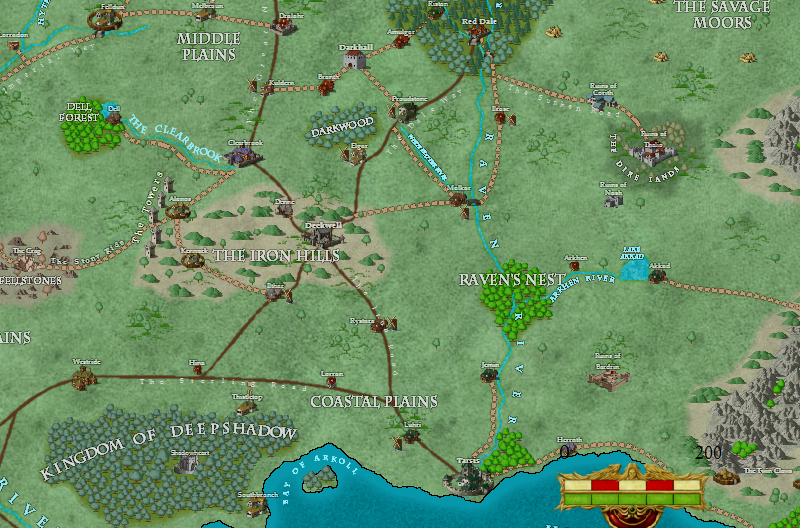So, it looks like I’m going to be going on the road for a long time for work. Like, ‘I’ll be done in early 2022’ long time. This will involve unimaginable levels of overtime, a passport, and living out of a suitcase.
I’m not sure if that will make me more productive or less, for writing. Some of my best work was written in airports or shitty conditions in foreign countries because I had nothing else to distract from creation, but a year? We’ll see.
Some of you may be aware that I made a tabletop RPG using the same universe as my books, some years ago. I have recently updated much of it and am distributing the materials to some playtesting groups. This has been tedious and time-consuming. ‘Making an RPG’ sounds all fun and creative, but you have to make and revise charts and tables of equipment and crunch various other sorts of numbers to make sure things will work correctly: early game, late game, and with feedback mechanisms or hard bounds so you don’t have runaway effects. Because sneaky munchkin players will find a way to break the system, if a way exists.
Good news is it seems to have been highly successful, subject to confirmation by the playtesters. The resulting machine is complex, in that it has many moving parts, but simple to handle and calculate. Much of it is intuitive and, therefore, easy to remember. Once the trilogy is complete, perhaps it can be pursued as a serious project for publication. The hardest parts would be marketing (because only lucky connoisseurs like you have any idea who I am) and art; I have a certain aesthetic that would need to be adhered to, requiring getting rights to particular styles or outright commissions. ‘Generic medieval fantasy art’ doesn’t fit terribly well. And so much of it these days is tainted by styles like World of Warcraft and Warhammer, which gigantic fucking pauldrons on ridiculously scaled suits of plate armor, with giant hands and weapons.
Poetry
I mentioned a poem. This came to me a few weeks ago, shortly after Thanksgiving when I was hit by the ‘Rona (did I forget to mention? I got COVID. Lost senses of taste and smell and three days of sniffles. Coughed like eight time. Big disappointment. That we’ve shut down society for nearly a year over what amounts to a easily-spread flu is absurd, and indicative of the pathetic incompetence and cowardice of our ‘rulers’).*
Wrote the whole thing in a few hours, edited it the next day. I think you’ll like it. It’s funny, reads kind of like The Night Before Christmas, and even has a moral. And if anyone knows anything about tabletop Blood Bowl, you’ll like the Easter Egg I put in.
The Dirtiest Halfling
In the back country,
there’s the town of Blackdust;
the color of mud,
if it mated with rust.
Between all the mounds
of filthy black coal
and billowing smoke,
was a dank little hole.
There lived a young man
alone in the muck,
content as a tick
on the back of a duck.
He had a workshop
way down in the dark
hole underground that
was lit up by sparks.
He was pretty happy,
quick of mind, sharp of wit.
His only real problem?
That he wallowed in shit.
A sorcerer with tools,
wizard with machines.
but each mess that he made
he would never clean.
All the work that he did
was dropped at his door
because no one could stand
the stuff stuck to his floor.
The air overflowed
with odors most foul.
It would’ve been better
with patties of cow.
The oils he spilled
would often catch fire,
burning white hot
and alerting the criers.
They’d raise the alarm,
firemen rushed there and stopped.
“Oh, it’s McDirty, working
down in his shop.”
You’d think them unhappy
to be played for saps
but most were just pleased
it burned off some of the crap.
Folk were disgusted
by his refusal of baths
and finally concluded,
“He’s a sociopath.”
Fungi abounded
With mold on the bricks:
But t’was the price people paid
To get their stuff fixed.
One day he left home,
and stepped out from his door
to get some fresh ointment
for a festering sore.
A cloud of plague flies
followed his wake
like a buzzing entourage
he just couldn’t shake.
And rather than greet him,
most fled back indoors,
slamming shut windows
and pretending to snore.
The old town doctor
sold McDirty his meds,
but couldn’t hold his breath
long and fell over, dead.
McDirty turned back
to return to his hole,
but something seized his attention:
a vision of gold!
Her form was a glory,
her movement was art.
There was something more
to this beautiful tart.
He straightened his back
and looked into her eyes,
but she ran right away
when she saw the flies.
McDirty was dismayed.
He wanted the girl,
but in this condition
she would only hurl.
Without drastic action
he’d be without hope.
So he went to the doctor’s
and picked up some soap.
It burned in his hand,
he dropped it and yelled.
Unaccustomed to cleaning,
his skin had rebelled.
He gritted his teeth
and smeared it with dirt,
to carry it home
even though it hurt.
McDirty sealed up his hole
and grabbed a large pot.
It took nearly an hour
just to scrub off the rot.
Then he boiled the water,
brought it to steam.
Even if it killed him,
he would get clean.
He loufa’d his skin,
broke through the crust,
shampoo’d his hair, and
drained all the pus.
He opened his closet
and pulled out a chest
left by his mother,
in peace may she rest;
a nice tailored outfit
of shimmering silk
and white fashionable hat
like pearlescent milk.
He emerged from his hole
a radiant swan,
unsure where the beautiful
girl might have gone.
He searched left and right
and adjusted his brim
while the townsfolk all whispered
and pointed at him.
“Oh my stars, there’s no smell.
Is that really McDirty?”
“Actually,” he said
with a smile. “It’s McMurty.”
News spread through the town
of Blackdust like a flash.
His miraculous change had
made quite a splash.
It took only minutes
to bring the girl out again.
Introductions were made,
her name was Elaine.
Their courtship was swift
and marriage came soon.
The married McMurties
were over the moon.
They both went back home
to the hole in the ground
where Elaine became furious
at what she then found.
McMurty’s new cleanliness
was only skin-deep.
The workshop and everything
inside it still reeked.
She yelled at her husband
and forced him to clean
all the oils and garbage
and maintain his hygiene.
He spent less time repairing
and more cleaning up slop.
It sucked all the fun
out of working his shop.
And as they lived together
he realized with dread
that Elaine couldn’t cook
and was lousy in bed.
Both professional and domestic
became more of a drag.
It got even worse
when she started to nag.
Then came the babies,
who crapped out a ton.
It smelled like before, but
without any of the fun.
A spoiled little princess
had been his Elaine.
Now married with children,
she went completely insane.
As her bosoms sank low
and her ass got wider,
she got ever more ornery
and never let him inside her.
Her rage would appear
in her eyes with a gleam,
and thunder throughout
the house with her screams.
McMurty was now trapped
with a creature of wrath,
and it was all because
the fool took a bath.
He changed all his ways,
and abandoned his life
because he thought a pretty face
would make a good wife.
The screaming harassment
would never cease.
The only way out now
was death’s sweet release.
Oh, Right. The Book
Ch. 16 is essentially finished and Ch. 17 outlined. I re-did a big part of 16, last month, to improve flow and help with some characterization. Most of my energies have been dumped into the RPG, recently. I finished the biggest part of the rules revision today, so other than some formatting/organization changes and a revised character sheet (dossier, actually), it’s nearly ready to be handed over to the playtesters. Then, primary focus will be back on The Dark Brother.
Still not 100% how it’s going to end. As the second part of an established story, the structure is pretty different from The Mountain Throne.
I also finished the cover, complete with cover art. I won’t show the results until the complete first draft is finished, just in case I decide to change something, but it’s pretty sweet. It accompanies The Mountain Throne’s cover art quite well, despite coming from a different source.
Oh, fine. Here’s a peek.

That’s only part of the whole art, of course, because it’s a wraparound cover like the first book.
Hope you liked The Dirtiest Halfling!
*[‘But COVID has killed hundreds of thousands of people!‘ So? Cancer kills 500 to 600 thousand people per year in the USA, and no one even notices unless it affects them. Recovery rates for COVID are north of 99.9% for every demographic there is except the seriously ill and elderly. You know, just like regular flu. Sweden handled it right. We didn’t. That’s especially shameful because, of all the pansified wuss-nations on Earth, Sweden’s in the top three.

And since I’m on the topic, cloth masks are useless superstitious talismans (they cannot even stop smoke particles, which are an order of magnitude larger scale than viruses [microns v. nanometers]) and ‘social distancing’ is pseudo-scientific nonsense. These virus particles supposedly live outside hosts for hours. You’re inside buildings with common ventilation systems. Unless you have a filtration system that can stop 125nm virus bodies and which sucks the air out of your face before it disperses to others, you’re all breathing the same air. That every level of government has been abused to put entire populations under what amounts to house arrest for fear that they might get a cold, forcing them to obey asinine and unproductive orders that don’t actually help but that certainly destroy people’s careers and lives, is a demonstration of just how pathetically ignorant, weak, and drunk on power what we may laughably refer to as our ‘leaders’ really are. It’s especially insulting when law enforcement is used to enforce COVID regulations, but look the other way regarding riots, arson, and political violence. Shows you where politicians’ priorities are, doesn’t it?
And the saddest part of the whole stupid situation of mass insanity is the response of the population. Every other engineer I’ve talked to about this has said some version of, ‘yeah, you’re right, but whateryagonnado?’ It’s obvious that these measures are not only useless but counterproductive; it can be explained as simply as I just did. Entire studies have been conducted on these topics, coming to these same, obvious conclusions. But no one seems to care, except about burying said studies so the peasants cannot see them.
And now the precedent has been set that politicians can force people to do things that not only do not help but actually make things worse, based on fiction, and then ignore those restrictions themselves without consequence. Even the most cynical of cyberpunk and conspiracy thriller writers didn’t foresee this. Their massive public lies have to be plausible, not clearly disprovable by literally anyone, and the liars have to pretend to believe them in public. Turns out that as long you can still watch child porn on Netflix and get the occasional government check, you can tell people to do any damned thing for any made up bullshit reasons and they won’t challenge you, even if your actions make it perfectly clear the reasons are bullshit and your words are lies.]








